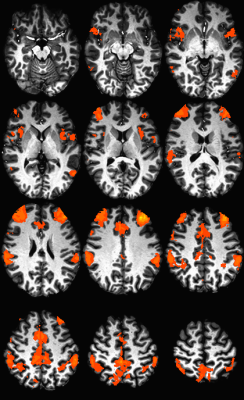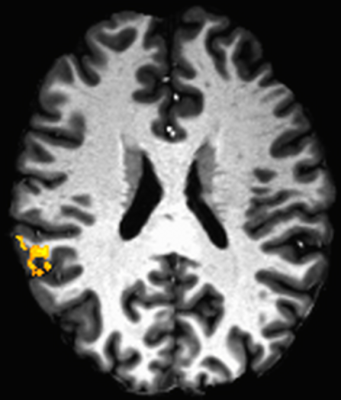3281
A preliminary report: Confirmation of the relationship of episodic memory performance and frontoparietal functional connectivity in Multiple Sclerosis1Imaging Sciences, The Cleveland Clinic, Cleveland, OH, United States, 2Neurological Institute, The Cleveland Clinic, Cleveland, OH, United States, 3Schey Center for Cognitive Neuroimaging, The Cleveland Clinic, Cleveland, OH, United States
Synopsis
This work assesses the relationship of resting state fMRI (rs-fMRI) of the dorsal lateral prefrontal cortex to episodic memory in patients with multiple sclerosis (MS). We find that rs-fMRI in the frontoparietal network is related to performance on a verbal episodic memory measure. This finding confirms previous reports and suggests this measure is appropriate to investigate as a potential predictive marker of cognitive decline.
Introduction
Approximately half of individuals affected by from multiple sclerosis (MS) experience cognitive dysfunction,1 which can have a major impact on quality of life and is associated with increased depression and decreased employment. There is currently no measure that can predict which patients are at risk of cognitive decline. Here we present preliminary baseline results from a large longitudinal study, the aim of which is to define neuroimaging markers related to cognitive decline. Our previous work found that resting state functional connectivity (rs-fMRI) of the dorsal lateral prefrontal cortex (DLPFC) was related to cognitive performance in MS, particularly to episodic memory.2 We focus on our hypothesis that the strength of rs-fMRI from the DLPFC to the parietal lobe will be related to episodic memory in MS.Methods
In an IRB-approved protocol, twenty-three patients with MS (age: 50.96 ± 8.0, 6 males, EDSS: 4.1 ± 1.7) were scanned on a Siemens 7T Magnetom with SC72 gradient (Siemens Medical Solutions, Erlangen) using a 32-channel head coil (Nova Medical). All participants completed the SRT, a measure of verbal episodic memory, and the BVMT-R, a measure of visual spatial episodic memory.
MRI acquisition
A whole-brain anatomical MP2RAGE (0.75mm isotropic voxel size; WIP 900) and a rs-fMRI scan (WIP 770B) were acquired. Rs-fMRI acquisition parameters were as follows: 132 repetitions of 81 1.5mm thick axial slices acquired with TE/TR=21ms/2800ms, matrix 160x160, FOV 210mm x 210mm, receive bandwidth = 1562 Hz/pixel. Subjects were instructed to keep their eyes closed during scans.
Data analysis
Rs-fMRI scans were corrected for motion and physiologic noise, detrended, and lowpass filtered.3,4 Using a previously described method and a functionally-defined template,5,6 nine-voxel in-plane seeds were placed in the left DLPFC to evaluate the strength of the fronto-parietal network. Whole-brain correlation maps were normalized7 and transformed into common space. For all subjects, rs-fMRI maps were correlated on a voxel-wise basis with episodic memory performance.
Results
Figure 1 shows the whole-brain average connectivity to the left DLPFC (p < 0.001, cluster size 85). Figure 2 shows that the strength of connectivity between the left DLPFC and the right angular gyrus is significantly related to SRT performance (p = 0.01, cluster size = 414). No regions were significantly related to BVMT performance. Figure 3 shows the correlation of mean connectivity within the significant region and verbal memory performance.Discussion and Conclusion
Though this sample is limited, we are encouraged to find that rs-fMRI within the frontoparietal network is related to verbal episodic memory performance. Additional baseline visits are in progress, and longitudinal follow-ups will allow a comparison of changes in rs-fMRI to changes in episodic memory. Based on recent findings from a different longitudinal sample,8 we also suspect that rs-fMRI measures at baseline may be more strongly related to later cognitive performance.
Acknowledgements
This work was supported by the Department of Defense (MS150097). The authors gratefully acknowledge technical support by Siemens Medical Solutions, Dr. Tobias Kober, and Dr. Himanshu Bhat.References
1. Achiron A, Chapman J, Magalashvili D, Dolev M, Lavie M, Bercovich E, et al. Modeling of Cognitive Impairment by Disease Duration in Multiple Sclerosis: A Cross-Sectional Study. PLoS One. 2013;8(8):e71058
2. Koenig, K.A., Sakaie, K.E., Lowe, M.J., Lin, J., Stone, L., Bermel, R.A., Beall, E.B., Rao, S.M., Trapp, B.D., Phillips, M.D. (2013, June) Dorsolateral prefrontal connectivity relates to episodic memory in Multiple Sclerosis. Poster presented at the meeting of the Organization for Human Brain Mapping, Seattle, Washington.
3. Beall EB and Lowe MJ. (2014) SimPACE: generating simulated motion corrupted BOLD data with synthetic-navigated acquisition for the development and evaluation of SLOMOCO: a new, highly effective slicewise motion correction. Neuroimage. 101:21-34.
4. Glover et al. (2000) Image-Based Method for Retrospective Correction of Physiological Motion Effects in fMRI: RETROICOR. Magnetic Resonance in Medicine. 44:162-67.
5. Sallet J, Mars RB, Noonan MP, et al. (2013) The Organization of Dorsal Frontal Cortex in Humans and Macaques. The Journal of Neuroscience. 33: 12255-74
6. Lowe et al. (2014) Anatomic connectivity assessed using pathway radial diffusivity is related to functional connectivity in monosynaptic pathways. Brain Connectivity. 4(7):558-65.
7. Lowe et al. (1998) Functional connectivity in single and multislice echoplanar imaging using resting-state fluctuations. NeuroImage. 7(2):119-32.
8. Koenig, KA, Beall, EB, Lin, J, Sakaie, K, Stone, L, Rao, SM, Phillips, M, and Lowe, MJ. (2017, April) Functional and structural connectivity of the cingulate bundle related to future cognitive performance in MS. Oral presentation at the meeting of the International Society for Magnetic Resonance in Medicine, Honolulu, Hawaii.
Figures


